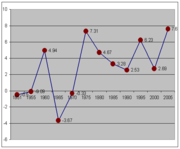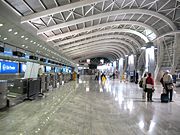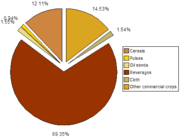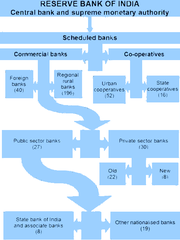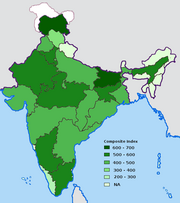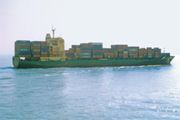Economy of India
2008/9 Schools Wikipedia Selection. Related subjects: Economics
| Economy of India | |
 |
|
| Currency | 1 Indian Rupee (INR) (₨) = 100 Paise |
|---|---|
| Fiscal year | April 1– March 31 |
| Trade organisations | WTO, SAFTA |
| Statistics | |
| GDP ( PPP) | $5.21 trillion (PPP) (2008 est.) ( 3rd) |
| GDP growth | 9.6% (2006/07) |
| GDP per capita | $1,089 (nominal); $4,543 (PPP) |
| GDP by sector | agriculture: 19.9%, industry: 19.3%, services: 60.7% (2006 est.) |
| Inflation ( CPI) | 3.5% (2008 est.) |
| Population below poverty line |
25% (2002 est.) |
| Labour force | 509.3 million (2006 est.) |
| Labour force by occupation |
agriculture: 60%, industry: 12%, services: 28% (2003) |
| Unemployment | 7.8% (2006 est.) |
| Main industries | textiles, chemicals, food processing, steel, transportation equipment, cement, mining, petroleum, machinery, software, services |
| External | |
| Exports | $125 billion (Financial Year 2006-2007) |
| Export goods | textile goods, gems and jewelry, engineering goods, chemicals, leather manufactures, services |
| Main export partners | US 18%, the People's Republic of China 8.9%, UAE 8.4%, UK 4.7%, Hong Kong 4.2% (2005) |
| Imports | $187.9 billion f.o.b. (2006 est.) |
| Import goods | crude oil, machinery, gems, fertilizer, chemicals |
| Main import partners | the People's Republic of China 7.2%, US 6.4%, Belgium 5.1%, Singapore 4.7%, Australia 4.2%, Germany 4.2%, UK 4.1% (2005) |
| Public finances | |
| Public debt | $132.1 billion (2006 est.) |
| Revenues | $109.4 billion (2006 est.) |
| Expenses | $143.8 billion; including capital expenditures of $15 billion (2006 est.) |
| Economic aid | donor: $17.3 million (2006) |
| Main data source: CIA World Factbook All values, unless otherwise stated, are in US dollars |
|
The economy of India, when measured in USD exchange-rate terms, is the twelfth largest in the world, with a GDP of US $1.25 trillion (2008). It is the third largest in terms of purchasing power parity. India is the second fastest growing major economy in the world, with a GDP growth rate of 9.4% for the fiscal year 2006–2007. However, India's huge population results in a per capita income of $4,542 at PPP and $1,089 at nominal (revised 2007 estimate). The World Bank classifies India as a low-income economy.
India's economy is diverse, encompassing agriculture, handicrafts, textile, manufacturing, and a multitude of services. Although two-thirds of the Indian workforce still earn their livelihood directly or indirectly through agriculture, services are a growing sector and play an increasingly important role of India's economy. The advent of the digital age, and the large number of young and educated populace fluent in English, is gradually transforming India as an important 'back office' destination for global outsourcing of customer services and technical support. India is a major exporter of highly-skilled workers in software and financial services, and software engineering. Other sectors like manufacturing, pharmaceuticals, biotechnology, nanotechnology, telecommunication, shipbuilding, aviation and tourism are showing strong potentials with higher growth rates.
India followed a socialist-inspired approach for most of its independent history, with strict government control over private sector participation, foreign trade, and foreign direct investment. However, since the early 1990s, India has gradually opened up its markets through economic reforms by reducing government controls on foreign trade and investment. The privatisation of publicly owned industries and the opening up of certain sectors to private and foreign interests has proceeded slowly amid political debate.
India faces a fastly growing population and the challenge of reducing economic and social inequality. Poverty remains a serious problem, although it has declined significantly since independence. Official surveys estimated that in the year 2004-2005, 27% of Indians were poor.
History
India's economic history can be broadly divided into three eras, beginning with the pre-colonial period lasting up to the 17th century. The advent of British colonisation started the colonial period in the 17th century, which ended with independence in 1947. The third period stretches from independence in 1947 until the present.
Pre-colonial
The citizens of the Indus Valley civilisation, a permanent and predominantly urban settlement that flourished between 2800 BC and 1800 BC, practised agriculture, domesticated animals, used uniform weights and measures, made tools and weapons, and traded with other cities. Evidence of well planned streets, a drainage system and water supply reveals their knowledge of urban planning, which included the world's first urban sanitation systems and the existence of a form of municipal government.
The 1872 census revealed that 99.3% of the population of the region constituting present-day India resided in villages, whose economies were largely isolated and self-sustaining, with agriculture the predominant occupation. This satisfied the food requirements of the village and provided raw materials for hand-based industries, such as textiles, food processing and crafts. Although many kingdoms and rulers issued coins, barter was prevalent. Villages paid a portion of their agricultural produce as revenue to the rulers, while its craftsmen received a part of the crops at harvest time for their services.
Religion, especially Hinduism, and the caste and the joint family systems, played an influential role in shaping economic activities. The caste system functioned much like medieval European guilds, ensuring the division of labour, providing for the training of apprentices and, in some cases, allowing manufacturers to achieve narrow specialization. For instance, in certain regions, producing each variety of cloth was the speciality of a particular sub-caste.
Textiles such as muslin, Calicos, shawls, and agricultural products such as pepper, cinnamon, opium and indigo were exported to Europe, the Middle East and South East Asia in return for gold and silver.
Assessment of India's pre-colonial economy is mostly qualitative, owing to the lack of quantitative information. One estimate puts the revenue of Akbar's Mughal Empire in 1600 at £17.5 million, in contrast with the total revenue of Great Britain in 1800, which totalled £16 million. India, by the time of the arrival of the British, was a largely traditional agrarian economy with a dominant subsistence sector dependent on primitive technology. It existed alongside a competitively developed network of commerce, manufacturing and credit. After the fall of the Mughals, India was administered by Maratha Empire. The maratha empire's budget in 1740s, at its peak, was Rs. 100 million. After the loss at Panipat, the maratha empire disintegrated into confederate states of Gwalior, Baroda, Indore, Jhansi, Nagpur, Pune and Kolhapur. Gwalior state has a budget of Rs. 30M. However, at this time, British East India company entered the Indian political theatre. Until, 1857, when India was firmly under the British crown, the country remained in a state of political instability due to internecine wars and conflicts.
Colonial
Colonial rule brought a major change in the taxation environment from revenue taxes to property taxes resulting in mass impoverishment and destitution of the great majority of farmers. It also created an institutional environment that, on paper, guaranteed property rights among the colonizers, encouraged free trade, and created a single currency with fixed exchange rates, standardized weights and measures, capital markets, a well developed system of railways and telegraphs, a civil service that aimed to be free from political interference, and a common-law, adversarial legal system. India's colonisation by the British coincided with major changes in the world economy—industrialisation, and significant growth in production and trade. However, at the end of colonial rule, India inherited an economy that was one of the poorest in the developing world, with industrial development stalled, agriculture unable to feed a rapidly growing population, one of the world's lowest life expectancies, and low rates of literacy.
An estimate by Cambridge University historian Angus Maddison reveals that India's share of the world income fell from 22.6% in 1700, comparable to Europe's share of 23.3%, to a low of 3.8% in 1952. While Indian leaders during the Independence struggle, and left-nationalist economic historians have blamed colonial rule for the dismal state of India's economy in its aftermath, a broader macroeconomic view of India during this period reveals that there were sectors of growth and decline, resulting from changes brought about by colonialism and a world that was moving towards industrialisation and economic integration.
Independence to 1991
Indian economic policy after independence was influenced by the colonial experience (which was seen by Indian leaders as exploitative in nature) and by those leaders' exposure to Fabian socialism. Policy tended towards protectionism, with a strong emphasis on import substitution, industrialisation, state intervention in labour and financial markets, a large public sector, business regulation, and central planning. Jawaharlal Nehru, the first prime minister, along with the statistician Prasanta Chandra Mahalanobis, carried on by Indira Gandhi formulated and oversaw economic policy. They expected favourable outcomes from this strategy, because it involved both public and private sectors and was based on direct and indirect state intervention, rather than the more extreme Soviet-style central command system. The policy of concentrating simultaneously on capital- and technology-intensive heavy industry and subsidising manual, low-skill cottage industries was criticized by economist Milton Friedman, who thought it would waste capital and labour, and retard the development of small manufacturers.
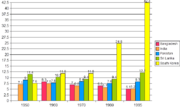
India's low average growth rate from 1947–80 was derisively referred to as the Hindu rate of growth, because of the unfavourable comparison with growth rates in other Asian countries, especially the "East Asian Tigers".
After 1991
In the late 80s, the government led by Rajiv Gandhi eased restrictions on capacity expansion for incumbents, removed price controls and reduced corporate taxes. While this increased the rate of growth, it also led to high fiscal deficits and a worsening current account. The collapse of the Soviet Union, which was India's major trading partner, and the first Gulf War, which caused a spike in oil prices, caused a major balance-of-payments crisis for India, which found itself facing the prospect of defaulting on its loans. In response, Prime Minister Narasimha Rao along with his finance minister Manmohan Singh initiated the economic liberalisation of 1991. The reforms did away with the Licence Raj (investment, industrial and import licensing) and ended many public monopolies, allowing automatic approval of foreign direct investment in many sectors. Since then, the overall direction of liberalisation has remained the same, irrespective of the ruling party, although no party has yet tried to take on powerful lobbies such as the trade unions and farmers, or contentious issues such as reforming labour laws and reducing agricultural subsidies.
Since 1990 India has emerged as one of the wealthiest economies in the developing world; during this period, the economy has grown constantly, but with a few major setbacks. This has been accompanied by increases in life expectancy, literacy rates and food security.
While the credit rating of India was hit by its nuclear tests in 1998, it has been raised to investment level in 2007 by S&P and Moody's. In 2003, Goldman Sachs predicted that India's GDP in current prices will overtake France and Italy by 2020, Germany, UK and Russia by 2025 and Japan by 2035. By 2035, it was projected to be the third largest economy of the world, behind US and China.
Government intervention
State planning and the mixed economy
After independence, India opted for a centrally planned economy to try to achieve an effective and equitable allocation of national resources and balanced economic development. The process of formulation and direction of the Five-Year Plans is carried out by the Planning Commission, headed by the Prime Minister of India as its chairperson.
India's mixed economy combines features of both capitalist market economy and the socialist command economy, but has shifted more towards the former over the past decade. The public sector generally covers areas which are deemed too important or not profitable enough to leave to the market, including such services as the railways and postal system.
Since independence, there have been phases of nationalizing such areas as banking and, more recently, of privatization.
Public expenditure
India's public expenditure is classified as development expenditure, comprising central plan expenditure and central assistance and non-development expenditures; these categories can each be divided into capital expenditure and revenue expenditure. Central plan expenditure is allocated to development schemes outlined in the plans of the central government and public sector undertakings; central assistance refers to financial assistance and developmental loans given for plans of the state governments and union territories. Non-development capital expenditure comprises capital defense expenditure, loans to public enterprises, states and union territories and foreign governments, while non-development revenue expenditure comprises revenue defence expenditure, administrative expenditure, subsidies, debt relief to farmers, postal deficit, pensions, social and economic services (education, health, agriculture, science and technology), grants to states and union territories and foreign governments.
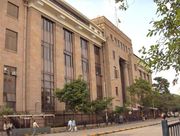
India's non-development revenue expenditure has increased nearly fivefold in 2003–04 since 1990–91 and more than tenfold since 1985–1986. Interest payments are the single largest item of expenditure and accounted for more than 40% of the total non development expenditure in the 2003–04 budget. Defence expenditure increased fourfold during the same period and has been increasing due to growing tensions in the region, the expensive dispute with Pakistan over Jammu and Kashmir and an effort to modernise the military. Administrative expenses are compounded by a large salary and pension bill, which rises periodically due to revisions in wages, dearness allowance etc. subsidies on food, fertilizers, education and petroleum and other merit and non-merit subsidies account are not only continuously rising, especially because of rising crude oil and food prices, but are also harder to rein in, because of political compulsions.
Public receipts
India has a three-tier tax structure, wherein the constitution empowers the union government to levy Income tax, tax on capital transactions ( wealth tax, inheritance tax), sales tax, service tax, customs and excise duties and the state governments to levy sales tax on intra-state sale of goods, tax on entertainment and professions, excise duties on manufacture of alcohol, stamp duties on transfer of property and collect land revenue (levy on land owned). The local governments are empowered by the state government to levy property tax, Octroi and charge users for public utilities like water supply, sewage etc. More than half of the revenues of the union and state governments come from taxes, of which half come from Indirect taxes. More than a quarter of the union government's tax revenues is shared with the state governments.
The tax reforms, initiated in 1991, have sought to rationalise the tax structure and increase compliance by taking steps in the following directions:
- Reducing the rates of individual and corporate income taxes, excises, customs and making it more progressive
- Reducing exemptions and concessions
- Simplification of laws and procedures
- Introduction of Permanent account number to track monetary transactions
- 21 of the 29 states introduced Value added tax (VAT) on April 1, 2005 to replace the complex and multiple sales tax system
The non-tax revenues of the central government come from fiscal services, interest receipts, public sector dividends, etc., while the non-tax revenues of the States are grants from the central government, interest receipts, dividends and income from general, economic and social services.
Inter-State share in the federal tax pool is decided by the recommendations of the Finance Commission to the President.
General budget
The Finance minister of India presents the annual union budget in the Parliament on the last working day of February. The budget has to be passed by the Lok Sabha before it can come into effect on April 1, the start of India's fiscal year. The Union budget is preceded by an economic survey which outlines the broad direction of the budget and the economic performance of the country for the outgoing financial year. This economic survey involves all the various NGOs, women organizations, business people, old people associations etc.
India's union budget for 2005–06, had an estimated outlay of Rs.5,14,344 crores ($118 billion). Earnings from taxes amount to Rs. 2,73,466 crore ($63b). India's fiscal deficit amounts to 4.5% or 1,39,231 crore ($32b). The fiscal deficit is expected to be 3.8% of GDP, by March 2007.
Currency system
Rupee
The Rupee is the only legal tender accepted in India. The exchange rate as of October 13, 2007 is about 39.18 to a US dollar, 55.56 to a Euro, and 79.82 to a UK pound. The Indian rupee is accepted as legal tender in the neighboring Nepal and Bhutan, both of which peg their currency to that of the Indian rupee. The rupee is divided into 100 paise. The highest-denomination banknote is the 1,000 rupee note; the lowest-denomination coin in circulation is the 50 paise coin.
Exchange rates
Under the fixed exchange rate system, the value of the rupee was linked to the British pound sterling until 1946, and after independence, 30% of India's foreign trade was determined in pound sterling. In 1975, as per the floating exchange rate system, the value of the rupee was pegged to a basket of currencies and was tightly controlled by the Reserve Bank of India. Since 2005, its value has been appreciating against the US dollar, Euro and British Pound Sterling. Since liberalisation reforms in early 1990s, the rupee is fully convertible on trade and current account.
Labour
The large population puts further pressure on infrastructure and social services. A positive factor has been the large working-age population, which forms 45.33% of the population and is expected to increase substantially, because of the decreasing dependency ratio. The national labour market has been tightly regulated by successive governments ever since the Workmen's Compensation Act was passed in 1923.
Physical infrastructure
Since independence, India has allocated nearly half of the total outlay of the five-year plans for infrastructural development. Development of infrastructure was completely in the hands of the public sector and was plagued by corruption, bureaucratic inefficiencies, urban-bias and an inability to scale investment.
India's low spending on power, construction, transportation, telecommunications and real estate, at $31 billion or 6% of GDP in 2002 had prevented India from sustaining higher growth rates. This had prompted the government to partially open up infrastructure to the private sector allowing foreign investment which has helped in a sustained growth rate of close to 9% for the past six quarters. India holds second position in the world in roadways' construction, more than twice that of China. As of 2005 the electricity production was at 661.6 billion kWh with oil production standing at 785,000 bbl/day. India's prime import partners are : China 8.7%, US 6%, Germany 4.6%, Singapore 4.6%, Australia 4% as of 2006 CIA FactBook As of 15 January 2007, there were 2.10 million broadband lines in India. Low tele-density is the major hurdle for slow pickup in broadband services. Over 76% of the broadband lines were via DSL and the rest via cable modems.
Financial institutions
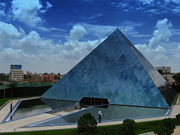
India inherited several institutions, such as the civil services, Reserve Bank of India, railways, etc., from her British rulers. Mumbai serves as the nation's commercial capital, with the Reserve Bank of India (RBI), Bombay Stock Exchange (BSE) and the National Stock Exchange (NSE) located here. The headquarters of many financial institutions are also located in the city.
The RBI, the country's central bank was established on 1 April 1935. It serves as the nation's monetary authority, regulator and supervisor of the financial system, manager of exchange control and as an issuer of currency. The RBI is governed by a central board, headed by a governor who is appointed by the Central government of India.
The BSE Sensex or the BSE Sensitive Index is a value-weighted index composed of 30 companies with April 1979 as the base year (100). These companies have the largest and most actively traded stocks and are representative of various sectors, on the Exchange. They account for around one-fifth of the market capitalisation of the BSE. The Sensex is generally regarded as the most popular and precise barometer of the Indian stock markets. Incorporated in 1992, the National Stock Exchange is one of the largest and most advanced stock markets in India. The NSE is the world's third largest stock exchange in terms of transactions. There are a total of 23 stock exchanges in India, but the BSE and NSE comprise 83% of the volumes. The Securities and Exchange Board of India (SEBI), established in 1992, regulates the stock markets and other securities markets of the country.
Sectors
Agriculture
India ranks second worldwide in farm output. Agriculture and allied sectors like forestry, logging and fishing accounted for 18.6% of the GDP in 2005, employed 60% of the total workforce and despite a steady decline of its share in the GDP, is still the largest economic sector and plays a significant role in the overall socio-economic development of India. Yields per unit area of all crops have grown since 1950, due to the special emphasis placed on agriculture in the five-year plans and steady improvements in irrigation, technology, application of modern agricultural practices and provision of agricultural credit and subsidies since Green revolution in India. However, international comparisons reveal that the average yield in India is generally 30% to 50% of the highest average yield in the world.
The low productivity in India is a result of the following factors:
- Illiteracy, general socio-economic backwardness, slow progress in implementing land reforms and inadequate or inefficient finance and marketing services for farm produce.
- The average size of land holdings is very small (less than 20,000 m²) and is subject to fragmentation, due to land ceiling acts and in some cases, family disputes. Such small holdings are often over-manned, resulting in disguised unemployment and low productivity of labour.
- Adoption of modern agricultural practices and use of technology is inadequate, hampered by ignorance of such practices, high costs and impracticality in the case of small land holdings.
- Irrigation facilities are inadequate, as revealed by the fact that only 53.6% of the land was irrigated in 2000–01, which result in farmers still being dependent on rainfall, specifically the Monsoon season. A good monsoon results in a robust growth for the economy as a whole, while a poor monsoon leads to a sluggish growth. Farm credit is regulated by NABARD, which is the statutory apex agent for rural development in the subcontinent.
Industry
India is fourteenth in the world in factory output. They together account for 27.6% of the GDP and employ 17% of the total workforce. However, about one-third of the industrial labour force is engaged in simple household manufacturing only.
Economic reforms brought foreign competition, led to privatisation of certain public sector industries, opened up sectors hitherto reserved for the public sector and led to an expansion in the production of fast-moving consumer goods.
Post-liberalisation, the Indian private sector, which was usually run by oligopolies of old family firms and required political connections to prosper was faced with foreign competition, including the threat of cheaper Chinese imports. It has since handled the change by squeezing costs, revamping management, focusing on designing new products and relying on low labour costs and technology.
34 Indian companies have been listed in the Forbes Global 2000 ranking for 2007. The 10 leading companies are:
| World Rank | Company | Logo | Industry | Revenue (billion $) |
Profits (billion $) |
Assets (billion $) |
Market Value (billion $) |
|---|---|---|---|---|---|---|---|
| 239 | Oil and Natural Gas Corporation | |
Oil & Gas Operations | 15.64 | 3.46 | 26.98 | 38.19 |
| 258 | Reliance Industries | |
Oil & Gas Operations | 18.05 | 2.11 | 21.75 | 42.62 |
| 326 | State Bank of India | |
Banking | 13.66 | 1.24 | 156.37 | 12.35 |
| 399 | Indian Oil Corporation | Oil & Gas Operations | 34.22 | 1.11 | 22.68 | 10.92 | |
| 494 | NTPC | |
Utilities | 6.06 | 1.31 | 17.25 | 26.06 |
| 536 | ICICI Bank | |
Banking | 5.79 | 0.54 | 62.13 | 16.72 |
| 800 | Steel Authority of India Limited | |
Materials | 6.30 | 0.91 | 7.06 | 10.16 |
| 1047 | Tata Consultancy Svcs | Image:TCS LOGO.JPG | Software & Services | 2.98 | 0.67 | 1.93 | 26.27 |
| 1128 | Tata Steel | |
Materials | 4.54 | 0.84 | 4.61 | 5.80 |
| 1130 | Infosys Technologies | Image:Infosys logo sml.gif | Software & Services | 2.14 | 0.55 | 2.09 | 26.19 |
Services
India is fifteenth in services output. It provides employment to 23% of work force, and it is growing fast, growth rate 7.5% in 1991–2000 up from 4.5% in 1951–80. It has the largest share in the GDP, accounting for 53.8% in 2005 up from 15% in 1950. Business services ( information technology, information technology enabled services, business process outsourcing) are among the fastest growing sectors contributing to one third of the total output of services in 2000. The growth in the IT sector is attributed to increased specialisation, availability of a large pool of low cost, but highly skilled, educated and fluent English-speaking workers (a legacy of British Colonialism) on the supply side and on the demand side, increased demand from foreign consumers interested in India's service exports or those looking to outsource their operations. India's IT industry, despite contributing significantly to its balance of payments, accounted for only about 1% of the total GDP or 1/50th of the total services.
Banking and finance
The Indian money market is classified into: the organised sector (comprising private, public and foreign owned commercial banks and cooperative banks, together known as scheduled banks); and the unorganised sector (comprising individual or family owned indigenous bankers or money lenders and non-banking financial companies (NBFCs)). The unorganised sector and microcredit are still preferred over traditional banks in rural and sub-urban areas, especially for non-productive purposes, like ceremonies and short duration loans.
Prime Minister Indira Gandhi nationalised 14 banks in 1969, followed by six others in 1980, and made it mandatory for banks to provide 40% of their net credit to priority sectors like agriculture, small-scale industry, retail trade, small businesses, etc. to ensure that the banks fulfill their social and developmental goals. Since then, the number of bank branches has increased from 10,120 in 1969 to 98,910 in 2003 and the population covered by a branch decreased from 63,800 to 15,000 during the same period. The total deposits increased 32.6 times between 1971 to 1991 compared to 7 times between 1951 to 1971. Despite an increase of rural branches, from 1,860 or 22% of the total number of branches in 1969 to 32,270 or 48%, only 32,270 out of 5 lakh (500,000) villages are covered by a scheduled bank.
Since liberalisation, the government has approved significant banking reforms. While some of these relate to nationalised banks (like encouraging mergers, reducing government interference and increasing profitability and competitiveness), other reforms have opened up the banking and insurance sectors to private and foreign players.
Socio-economic characteristics
Poverty
Large numbers of India's people live in abject poverty. Wealth distribution in India is improving since the liberalization and with the end of the socialist rule termed as the license raj. While poverty in India has reduced significantly, official figures estimate that 27.5% of Indians still lived below the national poverty line in 2004-2005. A 2007 report by the state-run National Commission for Enterprises in the Unorganised Sector (NCEUS) found that 70% of Indians, or 800 million people, lived on less than 20 rupees per day with most working in "informal labour sector with no job or social security, living in abject poverty."
Since the early 1950s, successive governments have implemented various schemes, under planning, to alleviate poverty, that have met with partial success. All these programmes have relied upon the strategies of the Food for work programme and National Rural Employment Programme of the 1980s, which attempted to use the unemployed to generate productive assets and build rural infrastructure. In August 2005, the Indian parliament passed the Rural Employment Guarantee Bill, the largest programme of this type in terms of cost and coverage, which promises 100 days of minimum wage employment to every rural household in 200 of India's 600 districts. The question of whether economic reforms have reduced poverty or not has fuelled debates without generating any clear cut answers and has also put political pressure on further economic reforms, especially those involving the downsizing of labour and cutting agricultural subsidies.
Corruption
Corruption has been one of the pervasive problems affecting India. It takes the form of bribes, evasion of tax and exchange controls, embezzlement, etc. The economic reforms of 1991 reduced the red tape, bureaucracy and the Licence Raj that had strangled private enterprise and was blamed for the corruption and inefficiencies. Yet, a 2005 study by Transparency International (TI) India found that more than half of those surveyed had firsthand experience of paying bribe or peddling influence to get a job done in a public office.
The chief economic consequences of corruption are the loss to the exchequer, an unhealthy climate for investment and an increase in the cost of government-subsidised services. The TI India study estimates the monetary value of petty corruption in 11 basic services provided by the government, like education, healthcare, judiciary, police, etc., to be around Rs.21,068 crores. India still ranks in the bottom quartile of developing nations in terms of the ease of doing business, and compared to China, the average time taken to secure the clearances for a startup or to invoke bankruptcy is much greater.
The Right to Information Act (2005) and equivalent acts in the states, that require government officials to furnish information requested by citizens or face punitive action, computerisation of services and various central and state government acts that established vigilance commissions have considerably reduced corruption or at least have opened up avenues to redress grievances. The 2006 report by Transparency International puts India at 70th place and states that significant improvements were made by India in reducing corruption.
Occupations and unemployment
Agricultural and allied sectors accounted for about 57% of the total workforce in 1999–2000, down from 60% in 1993–94. While agriculture has faced stagnation in growth, services have seen a steady growth. Of the total workforce, 8% is in the organised sector, two-thirds of which are in the public sector. The NSSO survey estimated that in 1999–2000, 106 million, nearly 10% of the population were unemployed and the overall unemployment rate was 7.32%, with rural areas doing marginally better (7.21%) than urban areas (7.65%).
Unemployment in India is characterised by chronic underemployment or disguised unemployment. Government schemes that target eradication of both poverty and unemployment, (Which in recent decades has sent millions of poor and unskilled people into urban areas in search of livelihoods.) attempt to solve the problem, by providing financial assistance for setting up businesses, skill honing, setting up public sector enterprises, reservations in governments, etc. The decreased role of the public sector after liberalisation has further underlined the need for focusing on better education and has also put political pressure on further reforms.
Regional imbalance
One of the critical problems facing India's economy is the sharp and growing regional variations among India's different states and territories in terms of per capita income, poverty, availability of infrastructure and socio-economic development.
The five-year plans have attempted to reduce regional disparities by encouraging industrial development in the interior regions, but industries still tend to concentrate around urban areas and port cities After liberalization, the more advanced states are better placed to benefit from them, with infrastructure like well developed ports, urbanisation and an educated and skilled workforce which attract manufacturing and service sectors. The union and state governments of backward regions are trying to reduce the disparities by offering tax holidays, cheap land, etc., and focusing more on sectors like tourism, which although being geographically and historically determined, can become a source of growth and is faster to develop than other sectors.
External trade and investment
Global trade relations
| Rank | Country | Inflows (Million USD) |
Inflows (%) |
|---|---|---|---|
| 1 | 8,898 | 34.49% | |
| 2 | 4,389 | 17.08% | |
| 3 | 1,891 | 7.33% | |
| 4 | 1,847 | 7.16% | |
| 5 | 1,692 | 6.56% |
Until the liberalisation of 1991, India was largely and intentionally isolated from the world markets, to protect its fledging economy and to achieve self-reliance. Foreign trade was subject to import tariffs, export taxes and quantitative restrictions, while foreign direct investment was restricted by upper-limit equity participation, restrictions on technology transfer, export obligations and government approvals; these approvals were needed for nearly 60% of new FDI in the industrial sector. The restrictions ensured that FDI averaged only around $200M annually between 1985 and 1991; a large percentage of the capital flows consisted of foreign aid, commercial borrowing and deposits of non-resident Indians.
India's exports were stagnant for the first 15 years after independence, due to the predominance of tea, jute and cotton manufactures, demand for which was generally inelastic. Imports in the same period consisted predominantly of machinery, equipment and raw materials, due to nascent industrialisation. Since liberalisation, the value of India's international trade has become more broad-based and has risen to Rs. 63,080,109 crores in 2003–04 from Rs.1,250 crores in 1950–51. India's major trading partners are China, the US, the UAE, the UK, Japan and the EU. The exports during August 2006 were $10.3 billion up by 41.14% and import were $13.87 billion with an increase of 32.16% over the previous year .
India is a founding-member of General Agreement on Tariffs and Trade (GATT) since 1947 and its successor, the World Trade Organization. While participating actively in its general council meetings, India has been crucial in voicing the concerns of the developing world. For instance, India has continued its opposition to the inclusion of such matters as labour and environment issues and other non-tariff barriers into the WTO policies.
Balance of payments
Since independence, India's balance of payments on its current account has been negative. Since liberalisation in the 1990s (precipitated by a balance of payment crisis), India's exports have been consistently rising, covering 80.3% of its imports in 2002–03, up from 66.2% in 1990–91. Although India is still a net importer, since 1996–97, its overall balance of payments (i.e., including the capital account balance), has been positive, largely on account of increased foreign direct investment and deposits from non-resident Indians; until this time, the overall balance was only occasionally positive on account of external assistance and commercial borrowings. As a result, India's foreign currency reserves stood at $141bn in 2005–06. Now however the reserves have been sitting at $270 billion which could be used in infrastructural development of the country if used effectively.
India's reliance on external assistance and commercial borrowings has decreased since 1991–92, and since 2002–03, it has gradually been repaying these debts. Declining interest rates and reduced borrowings decreased India's debt service ratio to 14.1% in 2001–02, from 35.3% in 1990–91.
Foreign direct investment in India
As the third-largest economy in the world in PPP terms, India is undoubtedly one of the most preferred destinations for foreign direct investments (FDI); India has strength in information technology and other significant areas such as auto components, chemicals, apparels, pharmaceuticals and jewellery. India has always held promise for global investors, but its rigid FDI policies were a significant hindrance in this regard. However, as a result of a series of ambitious and positive economic reforms aimed at deregulating the economy and stimulating foreign investment, India has positioned itself as one of the front-runners of the rapidly growing Asia Pacific Region. India has a large pool of skilled managerial and technical expertise. The size of the middle-class population at 300 million exceeds the population of both the US and the EU, and represents a powerful consumer market.
India's recently liberalised FDI policy (2005) allows up to a 100% FDI stake in ventures. Industrial policy reforms have substantially reduced industrial licensing requirements, removed restrictions on expansion and facilitated easy access to foreign technology and foreign direct investment FDI. The upward moving growth curve of the real-estate sector owes some credit to a booming economy and liberalized FDI regime. In March 2005, the government amended the rules to allow 100 per cent FDI in the construction business. This automatic route has been permitted in townships, housing, built-up infrastructure and construction development projects including housing, commercial premises, hotels, resorts, hospitals, educational institutions, recreational facilities, and city- and regional-level infrastructure.


